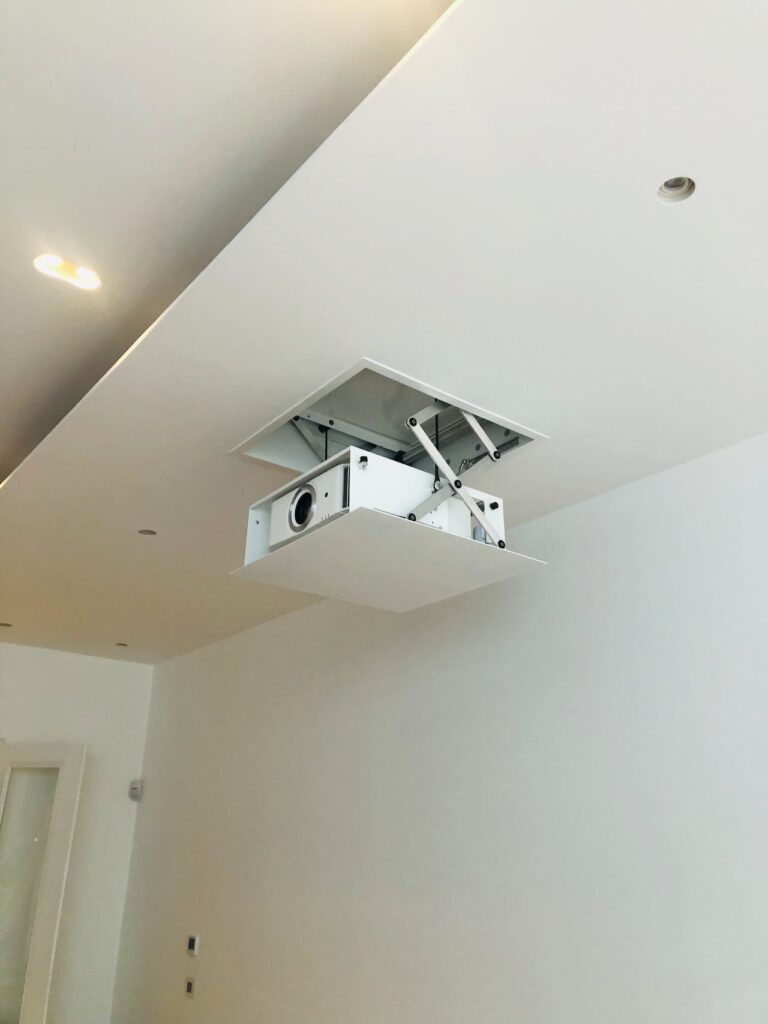Projectors For Sale Online
At Shop Scanner you will find the best projectors for sale for your home theatre systems on the market in South Africa.
Types of Projectors
Today, LCD, LED, and DLP projectors dominate the market. LCD, LED, and DLP allude to the projectors’ internal components and how they produce crisp images. Here are some of the different types you will find when browsing projectors for sale.
LCD projectors use polarised mirrors to reflect specific light colours. Each coloor is separated and recombined. Every colour flows through an LCD display that controls strength and saturation. LCD projectors are inexpensive and noted for their rich colour output.
LED projectors use red, blue, and green bulbs to create white light that travels through the lens to display an image. These projectors produce clean, high-resolution images with long light life. LED projectors are a mid-range solution with many variants for basic and advanced applications.
Digital DLP projectors feature numerous mirrors that can create over 16 million colours—who knew? DLP projectors produce more realistic images. Their internal mirrors are closer, creating more fluid, lifelike, and consistent pictures. DLP projectors contain the most technology, including Bluetooth and smart projector capabilities. Most modern DLP projectors can output 4k, bringing images to life with clear displays. However, a higher price tag is associated with better picture quality and technology. Advanced DLP projectors may be pricier, but they include cutting-edge technology that will elevate your home entertainment experience to a whole new level.

Understanding Specifications to Help You Choose From the Projectors for Sale
Contrast Ratio
Screen contrast ratio is a statistic that measures light and dark. Compare the luminance of the brightest white and darkest black on a screen to determine the contrast ratio. A 1000:1 contrast ratio indicates the brightest white is 1000x brighter than the darkest black. Thus, a high contrast ratio produces a stunningly detailed image.
If there isn’t a noticeable enough distinction between white and black, it could be difficult to view the rich cinematic content in the home theatre, where ambient light is usually present.
Resolution
Resolution is the number of pixels used to show a picture. Higher resolutions use more pixels, creating crisper, cleaner images. Projecting comprehensive charts, graphs, text, and HD video requires high resolution. A number combination like 1920 x 1200 indicates resolution. This means the screen image has 2,304,000 dots, 1920 horizontally and 1200 vertically.
- Lower-resolution SVGA (800×600 pixels, 4:3 aspect ratio) projectors are cheaper and suited for presenting small amounts of information, charts, and video clips.
- XGA (1024×768 pixels, 4:3): Popular. Most computers use XGA as their native resolution, hence XGA projectors are widespread.
- WXGA (1280×800 pixels, 16:10 aspect ratio): WXGA is XGA’s widescreen variant, matching vertical resolution but adding 20% horizontal resolution. This is a typical notebook and smartphone resolution.
- High-end notebooks and workstations are using WUXGA (1920×1200 pixels, 16:10 aspect ratio). In addition, WUXGA is used for installation projectors and huge venues that need bright, HD information.
- The most common format for cheap movie projection is 720p (1280×720 pixels, 16:9). It matches 720p HDTV.
- Standard home theater format is 1080p (1920×1080 pixels, 16:9 aspect ratio). It matches Blu-ray and 1080i/1080p HDTV.
Throwing Distance, Position
The arrangement of your room will dictate the placement of the projector and the size of the image. Therefore, you must examine the throw distance and projector capabilities that provide placement flexibility. Projector throw distance is the distance between the projector and the screen picture (the image is “thrown”).
- Long Throw: Projectors mounted in the centre of the ceiling in large rooms can produce very large images.
- Short throw projectors on the wall or ceiling near the wall project huge images while reducing shadows and eye glare. Short-throw projection ranges from 1m to 2.5m from projector to screen.
- Ultra-short throw : This throw avoids shadows and eye glare from projectors on the wall, the ceiling near a wall, or a table projecting downwards. Ultra-short throw projection is 0–1.2m from projector to screen.

Wireless or Wired
- A wireless-ENABLED projector. This indicates that the projector includes an 802.11 b/g/n wireless LAN. As soon as the included LAN module is inserted, the projector will begin wireless projection.
- A wireless projector as an option; to initiate the wireless function, one must acquire the wireless LAN module. Wireless projection is possible by simply connecting the purchased LAN module to the projector.
Technologies for Projections
The two most common types of projector technology are 1-chip DLP and 3-chip 3LCD.
- The 3-chip 3LCD technology provides energy-efficient projection while still producing vivid, lifelike images. In addition to a high white brightness, 3LCD projectors also feature a high colour brightness.
- Compared to 3LCD technology, the colour light output of 1-chip DLP technology is lower since it uses a spinning colour wheel to render colour.
Interactivity
You get all the benefits of an interactive whiteboard—interactivity, mobility, and affordability—in a single device with the projector and pen. You can project without glare or shadow using an interactive projector with a short-throw or ultra-short throw distance. Using interactive features, you can display and annotate content from various sources, as well as make big or tiny interactive areas with interactive pens for navigating, clicking, and drawing.
Image Alignment and Modification
Using a projector becomes a breeze when it provides easy control over image alignment.
- Adjustments made manually should only require a few steps to complete. You can avoid navigating the menu by using the projector’s physical adjustment button or slider.
- A far more significant advantage is automatic adjustment, which permits immediate alignment without requiring any sort of user intervention.
The majority of projectors allow for some level of adjustment, however some are more sophisticated than others. Some ways to set up your projected image include features like as horizontal and vertical keystone correction, screen fit, zoom, quick corner, optional lenses, and horizontal easy-slide image correction .
Connections
A wide variety of connectors, including Display Port, Component, USB, and VGA, are available for use with projectors. With the right adaptor, you can make many different kinds of connections work with each other.
Projection via a Network
For purposes such as digital signs, meetings, and presentations, content can be transmitted from a computer to a projector via a network. Your options with the Easy MP Network Projector program are:
From a single computer, you can send one or more images to various projectors. Presenters can share the projector without having to swap cables. One projector can be linked to as many as 16 computers.



Why Buy A Projector From Us?
Make sure the image you project on the screen leaves a lasting impact on your audience when you shop for a new projector for a classroom, meeting room, or home theatre. At Shop Scanner we make sure you take the best option that will suit your budget. Your online payment is processed safely and effortlessly. Your projectors will arrive at their destination ready-to-use, thanks to our lightning-fast delivery and our helpful customer service team. You can have a wide selection of items, brands, and models at your fingertips when you buy at Shop Scanner.
Frequently Asked Questions
DLP projectors project video using DMD chips, which include millions of small mirrors. In comparison, LCD projectors use liquid crystal display technology and have better color accuracy.
A projector with 3,000 lumens or more will display clear images with ambient illumination or bright light.
Projectors range from 50 watts for cheap, portable devices to 800 watts for high-brightness ones. The right projector wattage depends on image quality, projection size, and energy efficiency.
Those who don’t mind power usage will love 4K projectors. These projectors use more energy than 1080p ones due to their increased pixel count, resolution, brightness, and clarity.
If you like our range of Projectors, you might also be interested in our selection of Home Theatre Systems
